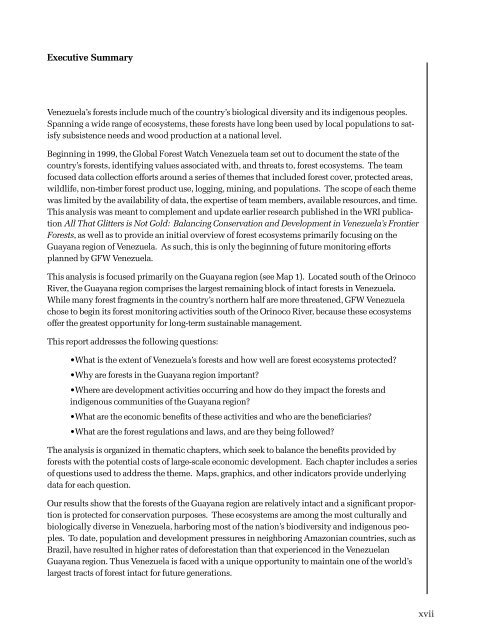Usar pâgs xvii-134 - ResearchGate
Usar pâgs xvii-134 - ResearchGate
Usar pâgs xvii-134 - ResearchGate
You also want an ePaper? Increase the reach of your titles
YUMPU automatically turns print PDFs into web optimized ePapers that Google loves.
Executive SummaryVenezuela’s forests include much of the country’s biological diversity and its indigenous peoples.Spanning a wide range of ecosystems, these forests have long been used by local populations to satisfysubsistence needs and wood production at a national level.Beginning in 1999, the Global Forest Watch Venezuela team set out to document the state of thecountry’s forests, identifying values associated with, and threats to, forest ecosystems. The teamfocused data collection efforts around a series of themes that included forest cover, protected areas,wildlife, non-timber forest product use, logging, mining, and populations. The scope of each themewas limited by the availability of data, the expertise of team members, available resources, and time.This analysis was meant to complement and update earlier research published in the WRI publicationAll That Glitters is Not Gold: Balancing Conservation and Development in Venezuela’s FrontierForests, as well as to provide an initial overview of forest ecosystems primarily focusing on theGuayana region of Venezuela. As such, this is only the beginning of future monitoring effortsplanned by GFW Venezuela.This analysis is focused primarily on the Guayana region (see Map 1). Located south of the OrinocoRiver, the Guayana region comprises the largest remaining block of intact forests in Venezuela.While many forest fragments in the country’s northern half are more threatened, GFW Venezuelachose to begin its forest monitoring activities south of the Orinoco River, because these ecosystemsoffer the greatest opportunity for long-term sustainable management.This report addresses the following questions:•What is the extent of Venezuela’s forests and how well are forest ecosystems protected?•Why are forests in the Guayana region important?•Where are development activities occurring and how do they impact the forests andindigenous communities of the Guayana region?•What are the economic benefits of these activities and who are the beneficiaries?•What are the forest regulations and laws, and are they being followed?The analysis is organized in thematic chapters, which seek to balance the benefits provided byforests with the potential costs of large-scale economic development. Each chapter includes a seriesof questions used to address the theme. Maps, graphics, and other indicators provide underlyingdata for each question.Our results show that the forests of the Guayana region are relatively intact and a significant proportionis protected for conservation purposes. These ecosystems are among the most culturally andbiologically diverse in Venezuela, harboring most of the nation’s biodiversity and indigenous peoples.To date, population and development pressures in neighboring Amazonian countries, such asBrazil, have resulted in higher rates of deforestation than that experienced in the VenezuelanGuayana region. Thus Venezuela is faced with a unique opportunity to maintain one of the world’slargest tracts of forest intact for future generations.<strong>xvii</strong>
















